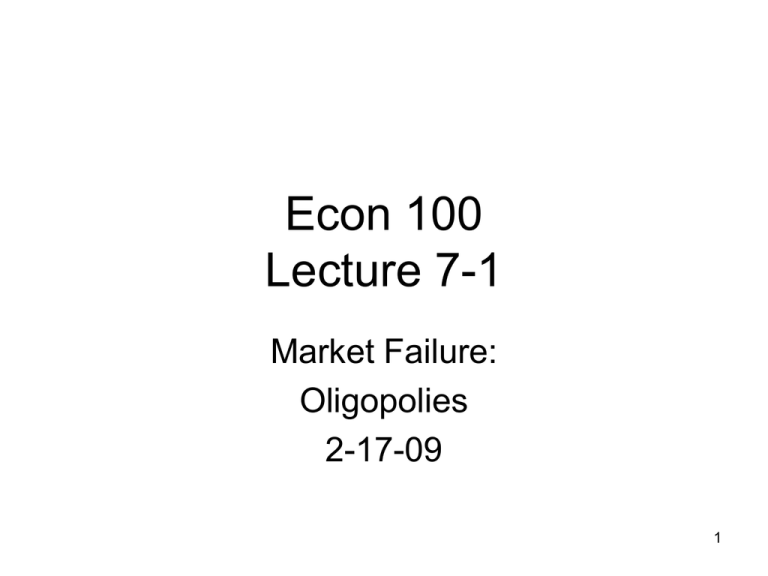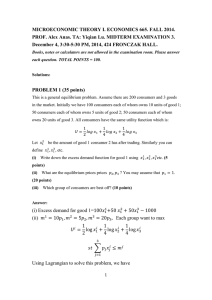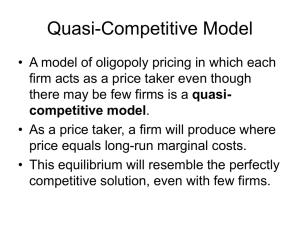Econ 100 Lecture 7-1 Market Failure: Oligopolies
advertisement

Econ 100
Lecture 7-1
Market Failure:
Oligopolies
2-17-09
1
This Week
• Test will cover
– Perfect Competition (Ch. 8)
– Monopoly (Ch. 8 & 9)
– Oligopoly (Ch. 9)
– Regulation (Ch. 10)
• Test is on Tuesday 2/24
2
Cartels
•
A cartel is a formal (explicit) agreement among firms.
–
–
•
Cartel members may agree on such matters
–
–
–
–
–
•
•
as price fixing,
total industry output,
market shares,
allocation of customers,
allocation of territories
aim of such collusion is to increase individual member's profits by reducing
competition.
–
•
usually occur in an oligopolistic industry, where there are a small number of sellers
usually involve homogeneous products.
Competition laws forbid cartels.
Several economic studies and legal decisions of antitrust authorities have found that
the median price increase achieved by cartels in the last 200 years is around 25%.
Private international cartels (those with participants from two or more nations) had an
average price increase of 28%, whereas domestic cartels averaged 18%. Less than
10% of all cartels in the sample failed to raise market prices
3
Oligopoly Behavior
• Cooperative Oligopoly
– Cartels
• Agree to collude; act/price like a single firm monoploist
– Price leadership (Stackleberg leader)
• Dominant firm establishes the price; other firms react to
“leader”
• Non-cooperative Oligopolies
– Sticky prices (kinked demand curve)
• Sticky upward
– Nash equilibrium
• Characterized by stable prices
– Perfect competition
• Completely rivalarous
4
Cartel Pricing Tactic
• Reduce Qs to monopoly levels in order to:
– a) obtain a higher price
– b) earn monopoly rents
5
How do Cartels Operate?
• Firms in the cartel need to agree on:
– 1) Market price
– 2) Quantity supplied by the Industry
– 3) Each firm’s “quota”
– 4) “Not to cheat” on either price or quantity
supplied
6
How Does the Cartel Do It?
• Determining output for the CARTEL
– Monopoly-like
• Choose either output or price for the cartel at the single-firm
monopolist level, either:
– Pmonopoly > Pcompetitive OR
– Qmonopoly < Q competitive
• Allocating Output Among Members
– Choose output levels for each member such that
marginal costs of production are equal
• mc1 = mc2 = … = mcn (for all firms in the cartel)
• Price for each member has been set previously for all at Pm
7
Figure 12.4 Duopoly Equilibrium in
a Centralized Cartel
Marg Cost at Profit Max
Each member’s quota set at MC for Cartel
8
Conditions for cartel success
• the cartel can significantly raise price
– Inelastic demand
• cartel controls market
– Few good substitutes outside the cartel
• low organizational costs
– few firms (or a few large ones)
– industry association
• many small buyers: no monopsony power
• cartel can be maintained
– cheating can be detected and prevented
– low expectation of severe government punishment
9
An Example of a Cartel
• Organization of the Petroleum Exporting Countries (OPEC) is an
international cartel made up of Algeria, Angola, Ecuador, Indonesia,
Iran, Iraq, Kuwait, Libya, Nigeria, Qatar, Saudi Arabia, the United
Arab Emirates, and Venezuela.
• Principal aim of the organization, according to its Statute, is the
determination of the best means for safeguarding their interests,
individually and collectively; devising ways and means of ensuring
the stabilization of prices in international oil markets with a view to
eliminating harmful and unnecessary fluctuations
• OPEC triggered high inflation across both the developing and
developed world using oil embargoes in the 1973 oil crisis.
• OPEC's ability to control the price of oil has diminished due to the
subsequent discovery/development of large oil reserves in the Gulf
of Mexico and the North Sea, the opening up of Russia, and market
modernization.
• OPEC nations still account for two-thirds of the world's oil reserves,
and, in 2005, 41.7% of the world's oil production,
10
Oligopoly
• Oligopoly markets are more concentrated than
monopolistically competitive markets,
but less concentrated than monopolies.
Perfect
Competition
Monopolistic
Competition
Monopoly
Oligopoly
11
Strategic Behavior
• Perfect Competition
– Only strategy is to reduce costs
• Price-taker => output decisions do not affect market price
– cross-price elasticity = -1 (perfect substitutes)
– Own-price = -∞
• Monopoly
– Price-Searcher: output decision determines price
• Cross-price = 0 (no substitutes)
• Own-price: >= |1| {at profit maximizing output/price}
• Oligopoly
– Cross-price elasticity near -1 {for members within the cartel}
• Cross-price elasticity near 0 for non-members (no switching)
– Own-price elasticity > |1| {for cartel at profit-max price}
– Will have to take into account actions of other similar firms when making
output/pricing decisions unless they can create an effective cartel
• Much more strategy
12
Firms “cheat”
• luckily for consumers, cartels often fail
because each firm in a cartel has an
incentive to cheat on the cartel agreement
• cheating firm
– produces extra output or lowers its price
– ignores the negative effect of its extra output
on other firms’ profits
13
Factors that work against a Cartel
- in the long run
• Each firm has an incentive to cheat
– Price that firm receives is still above MC of
production
• Could earn additional profits by slightly expanding
output
• However, when all firms do this
– -> back at competitive market outcome
• Qs up to point where MV=MC
• See “prisoners dilemma”
14
What market conditions make
Cartels more likely?
• Market demand is inelastic
– higher prices lead to increase revenues for the cartel
• Homogenous goods
– easier to initially set/enforce cartel price
• Small number of firms/high concentration of
market share (easier to monitor, collude)
– Fringe players could defeat cartel
– More equal shares -> increase incentive to cheat
15
Price-leadership
• Stackelberg price leadership model
– Not explicitly collusive
– Requires a dominant firm (large market share and
some market power)
– Firms are allowed to change prices within a certain
range
• If firm(s) lower price(s) below the “allowed” range, then
dominant firm retaliates with lower price and takes away
market share
– Example: AT&T in the LD market after “Divestiture”
16
Non-Cooperative Cartels
• Some degree of price competition
– Firms engage in highly competitive pricing
• Similar outcome as perfect competition
– Firms have some market power
• Resembles monopolistic competition
• Stable prices prevail
– Non-collusive
– Firms choose not to compete because of
kinked demand curve
17
Kinked-Demand Curve
• Above the kink, demand is relatively elastic because all other firm’s
prices remain unchanged. Below the kink, demand is relatively
inelastic because all other firms will introduce a similar price cut,
eventually leading to a price war. Therefore, the best option for the
oligopolist is to produce at point E which is the equilibrium point
18
Nash Equilibrium
• If firm facing kinked demand curve tries to
raise price:
– Other firms do not
– As demand is highly elastic and other firms
are “close” substitutes
– Loses market share and revenues
• If firm lowers price
– Competitors match price decreases
19
Nash Equilibrium
• As a consequence
– Best strategy is to neither raise or lower
prices; but to maintain “stable” prices
• Nash equilibrium in an oligopolist market
will be characterized by long-term stable
prices or “sticky” prices
– Non-price competition
• Advertising to create brand name
awareness/loyalty
• Product proliferation
20




